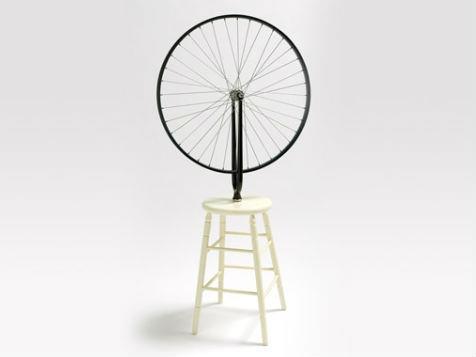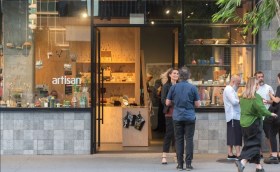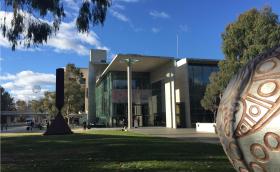Marcel Duchamp, arguably the most influential figures in 20th century art and originator of the readymade, radically expanded the definition of what we consider to be art. By specifically choosing and exhibiting a mass produced object rather than making something himself, Duchamp’s first readymade the Bicycle Wheel 1913 was at once provocative and ingenious and is now archetypal.
What’s happened since Duchamp’s notorious gesture is the subject of the exhibition Reinventing the Wheel: the Readymade Century now showing at Monash University Museum of Art as part of the Melbourne Festival. Is (as the title playfully suggests) art made since Duchamp’s throw down a century ago unnecessary and redundant? An attempt to reinvent something already perfected? A facsimile of a facsimile?
The exhibition contains two of Duchamp’s readymades, the Bicycle Wheel 1913 and Bottle Rack 1914 (both works reconstructed in 1964). The curatorial thesis, that Duchamp’s toppling of traditional conceptions of art/artist continues to reverberate, is borne out in the other works by over forty international and Australian artists in this large group show.
Duchamp’s readymades subverted the status of the artist as the maker of an art object. The reduction of the role of the artist in the execution of the work is seen in Carl Andre’s Steel-copper plain 1969, its minimalist restriction of material and form is pared back and humble. Cuban-American artist Felix Gonzales-Torres’ work embraced this instability. Untitled (A corner of Baci) 1990 is a pile of silver foil wrapped Baci chocolates in one corner of the gallery.
Joseph Kosuth’s triptych One and three tables 1965, an early work from the conceptual artist, consists of a real wooden table, a photograph of the table in situ and a dictionary definition of the word table. Kosuth questions modes of representation in a stripped back elemental way. In comparison Melbourne artist James Lynch’s Real Life is Everywhere 1998 is made up of carefully constructed replicas of our throwaway culture in paper and colour pencil. The colourful array of items are dramatically spot lit, elevating the fast food cartons, train tickets and soda cans to the status of high art.
Humour, wit and irony were important features of Duchamp’s oeuvre; his readymades were essentially attempt at non-art for his own amusement. The exhibition traces the continuation this playful mockery of convention with works such as Matthew Griffen’s Minor Threat 2007 which is placed directly on the gallery floor. As we walk past Rupert Murdoch stares up from a Time magazine cover, over one eye is a Bounty chocolate bar, and below the title of the story ‘The Last Tycoon’. The visual pun uses everyday, familiar objects mischievously casting Murdoch as a pirate. On the wall nearby Andy Warhol’s pop art screen-print Campbell’s Soup II – Chedder Cheese 1969 ironically transforms the commonplace with high impact results.
MUMA’s exhibition pays tribute to Duchamp’s revolutionary readymade and uses the occasion of its centenary to explore the artistic practices that continue to engage these themes.
Rating: 4 stars
Reinventing the Wheel: the Readymade Century
3 October – 14 December 2013
Monash University Museum of Art Caulfield campus






